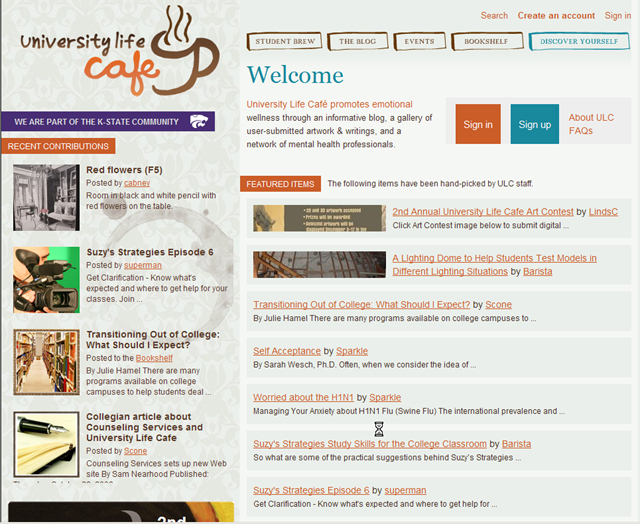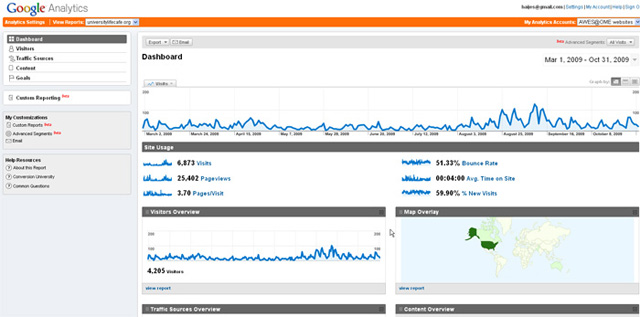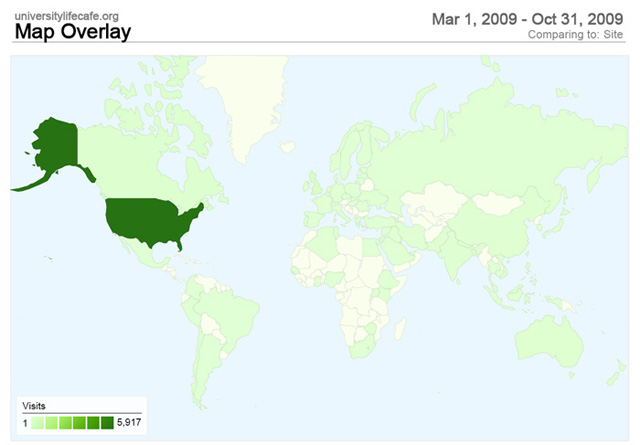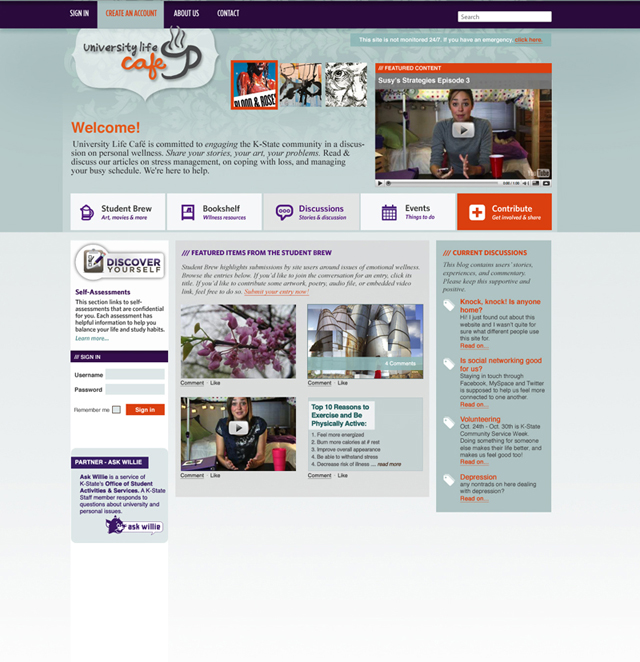- Contemporary technologies can be harnessed to meet community-building and emotional health objectives for university students.
- Cross-functional teams, student advisory committees, and campus partners add value when building a collaborative website designed to serve the campus community.
- To better engage and meet the needs of site users, websites need continual reevaluation and adaptation in response to the various feedback streams.
- Edutainment may have an important place in higher education, especially when used judiciously and strategically to increase student engagement.
Institutions of higher education have a vested interest in the health of their student populations, even without the traditional strictures of in loco parentis. Student health issues involve stress management, healthy diet and exercise, the building of healthy social lives, effective relationship management, and the development of life skills (time management, budgeting, and others). One critical aspect of student health involves suicide prevention:
Given the increasing number of students entering college with serious psychological problems, campus suicide may currently be more prevalent. In a 2007 survey by the American College Health Association, which included more than 70,000 students at 107 institutions, 9.8% reported seriously considering suicide at least once during the past school year and 1.5% reported making at least 1 suicide attempt.1
Traditional-age college students fall into a high-risk age group for suicides, with a young person (15 to 24) dying of suicide every 2 hours and 12 minutes, according to 2001 U.S. statistics. Suicide is the third leading cause of death for young people, with the first reason being accidents and the second being homicides. Suicide is the second leading cause of death among college students.2 Factors that may contribute to suicidal behavior among college students include major life transitions such as leaving home, going to college, and leaving family and peer supports.3
Extensive research has tried to identify symptoms or concerns among university students seeking counseling services. According to a study of over 3,800 students who sought counseling services at nine university counseling centers in the 2007 academic year, "the percentage of students who exhibited clinically significant indicators of self-harm was alarming (21%)." Self-harm indicators in this study included "intentions of suicide," "recent thoughts of suicide," and intentions of "hurting myself."4 As an extension of this study, a cluster analysis performed on 3,630 students who sought counseling services revealed seven groups of students who identified the severity of their symptoms or concerns.5 Table 1 highlights each cluster of students by symptoms or concerns, the percentage of respondents among the total who fit into that cluster, and each cluster’s defining characteristics.
Table 1. Cluster Analysis of Symptoms or Concerns of Students Seeking Counseling Services
| Cluster | Sample Size (Percentage of Respondents)* | Defining Characteristic |
| Elevated Distress | n = 91 (11.3%) |
|
| Self-Harm Concerns with Mood and Interpersonal Difficulties | n = 49 (6.1%) |
|
| Interpersonal Conflict with Mild to Moderate Mood Issues | n = 155 (19.2%) |
|
| Substance/Addiction Concerns | n = 61 (7.6%) |
|
| Food Concerns | n = 80 (9.9%) |
|
| Academic and Career Concerns | n = 118 (14.6%) |
|
| Mild Distress | n = 252 (31.3%) |
|
* N = 3,630 students
Universities are concerned not just with students’ perceived symptoms and needs; they focus on a range of supports to develop the whole student. Students who exhibit holistic mental and physical health often perform better academically than their less healthy peers. A Kansas State University study titled "Counseling Success: What Matters?" measured the impacts of health behaviors on college student outcome, as reported in the "KSU Counseling Services Annual Report (2008-2009) College Success: What Matters?" The study showed the significant association of healthy lifestyle behaviors with student performance in grade point average (GPA) and life satisfaction. Alcohol consumption and unhealthy eating had negative effects on GPA, whereas use of personal management skills had a salutary effect on academic performance. Personal management skills, healthy eating, and physical activity all enhanced life satisfaction for students.
With the popularization of socio-technical online spaces (high-tech spaces through which people interact, collaborate, and co-create), Web 2.0 ("Social Web") information technologies offer a new tool for the creation of protective factors against suicide, including a virtual student community. Raising awareness of suicide and de-stigmatizing that awareness are critical elements in building protective factors around students. It was in this spirit that Kansas State University began work on a website that would eventually become the University Life Café under the auspices of a federal grant from the Substance Abuse and Mental Health Services Administration (SAMHSA). The University Life Café aligns with university endeavors supporting student development of coping skills. Figure 1 shows the initial conceptualization of the site.

Figure 1. The University Life Café (v. 1.0) Entry Page
In February 2009, the University Life Café underwent a soft launch after a year of planning and collaboration between a student advisory group and a cross-functional team with expertise in information and communications technology, graphic design, counseling, instructional design, and law. The design team had brainstormed the general contents and functionalities of a socio-technical site that would promote the emotional health of university students in general while offering deeper services for K-State students in particular. They had conducted basic research on suicidology and website resources to lower risk factors of suicide and to strengthen protective factors against suicide. A graphic artist had designed a logo and a look and feel for the site. Legal counsel had created a policy that would protect the university and the site users. This endeavor was not without some potential risks to the school’s reputation, however, and the soft launch itself involved reaching out to members of the K-State campus community and those who supported building of the site.6
Students post digital imagery, video links, and audio files to the Student Brew area of the site, with contents that may be accessed by type:
This visitor contribution section offers flexibility to allow for a range of voices and points of view. Students can also post their ideas to the blog.
More official contents, such as articles and modules, are available through the Bookshelf. Formal heuristics (professionally created and validated self-assessments) may be accessed at Discover Yourself. The Events consist of more formal information posted by the university, although participants may send in announcements of events for possible inclusion by University Life Café staff.
Short videos aligned with the site contents have been scripted, videotaped, and made available through Vimeo and YouTube, with embedded distribution streams from the main University Life Café site. These videos have transcripts for Section 508 accessibility.
Art contests raise awareness of the site, its information, and its virtual community. These contests also attract students to the site and encourage them to share their artistic expressions through the University Life Café.
Legal disclaimers written into the Terms of Service protect Kansas State University and inform visitors of their rights, remedies, and obligations in using the site.
Figure 2 provides a slideshow tour of the University Life Café, from objectives to resources.
Meshing Site Objectives and Deployed Technologies
The University Life Café is a noncommercial academic endeavor that involved complex website objectives expressed through carefully selected technologies and strategically chosen (and presented) contents. Table 2 shows the tight integration of objectives with IT-enabled functionalities and digital contents.
Table 2. Site Objectives and Deployed Technologies
| Site Objectives | Deployed Technologies |
| Digital content uploading, management, and searchability | Django website with tagging capabilities |
| User interactivity with anonymity, privacy, and trackability; varying levels of access (general public vs. K-Stater) | Django website with text analysis and artificial intelligence |
| Site accessibility (Section 508 guidelines) | Video transcription and visual object annotation and labeling |
| Site branding | Django website with professional graphic design |
| Storytelling | Webisodes, scripted videos (with student actors) |
| Formal learning | Online modules (SoftChalk Lesson Builder); automated self-assessments; downloadable articles |
| Heuristics/self-assessments | Off-site heuristics; Axio Survey |
| Site analysis | Google Analytics |
| Art contests | Django website |
| Site publicity | Social networking sites; cross-linking; electronic mailing lists |
Role-Based Enablements
The general public may access the University Life Café’s contents — its photos, audio, videos, articles, blog postings, and events listings — and submit events for the calendar; visitors may also contact those hosting the site (K-State’s Counseling Center) with requests and commentary about the digital contents. This public sharing of contents reaches a larger community of students around the world, not just K-State students. It creates a larger sense of a global community, and, paradoxically, a deeper sense of local community for K-State students. The larger audience also might create a sense of accountability in terms of the work posted. Site policies specifically do not encourage those who want to post private messages. Visitors from K-State who want professional counseling and venues for more private disclosures are encouraged to reach out to K-State’s professional counselors.
Users who have K-State electronic identification (eID) may post messages to the blog and enter text responses to any of the mediated contents. Only K-State students may sign up for membership to the site. They may upload digital contents (audio, video, imagery, and other multimedia) with accompanying textual annotations. They may embed links to videos hosted on other servers. They may also access the formal reliability-tested heuristics with their K-State membership, as verified through their eIDs. This participatory aspect encourages student voices and self-expression; it also encourages a sense of community around shared, co-created knowledge.
For privacy reasons, K-State students may post to the site using public-facing pseudonyms that are not publicly trackable to who they are, but their real identities are visible on the back end to the K-State staff who have system operator-level access. This access enables tracking and responsiveness for students in crisis — those whose textual expressions trigger an artificial intelligence indicator. The system administrators include several professional counselors.
This prosumer-type enablement (students as producers and consumers of digital contents) raised concerns that the site’s professional approach might become diluted. Consequently, the information streams were differentiated into the Bookshelf, containing more formal content, and the Student Brew and Blog, containing more informal information.
Tailoring "Safe" Anti-Suicide Messages
The digital contents and messages delivered on the University Life Café site needed to follow the Suicide Prevention Resource Center (SPRC) guidelines for safe and effective messaging for suicide prevention. "Safe messaging" refers to the need to tailor messages for proper understanding by the audience.
The SPRC’s safe and effective messaging guidelines emphasize the importance of building protective factors against suicide by encouraging positive human relationships and empowering a community against suicide. Protective factors include:
- Suicide awareness
- Widespread knowledge of suicide signs and symptoms
- Empowerment to intervene on others’ behalf (by putting them in contact with trained counseling professionals)
- Encouragement of help-seeking behaviors (through both information and concrete action steps)
The SPRC highlights effective treatments for underlying mental health problems. Recommendations include not glorifying or romanticizing suicide or people who have died by suicide, not normalizing suicide as if it were a common event, and not oversimplifying suicide as a response to stress. Safe messaging suggests that people should not focus on the personal details of those who have died by suicide or their methods and should avoid inadvertently sending unintended or potentially harmful messages.
A mental wellness site should encourage help-seeking and offer multiple channels for people to access help (with references to the university counseling center during office hours and then to a toll-free national suicide prevention hotline during other hours). The University Life Café site offers resources to prevent suicide and provides information about warning signs for friends, family, acquaintances, and colleagues of those who might be suicidal. The site also offers tools to strengthen the protective factors against suicide and to lower suicide risks and communicates the message that there are effective treatments and interventions for those with mental health needs. The University Life Café site consciously avoids romanticizing suicide or those who have died by it; it also avoids normalizing suicide by presenting it as a common event. The policy for the University Life Café explicitly disallows the posting of memorials to those who have committed suicide and offers guidance for safe messaging.
All formal contents go through Barbara Pearson, assistant director of the Counseling Center and principal investigator of the federal SAMHSA grant. The designed contents (such as articles, videos, photos, and modules) are made to appeal to a wide range of populations, including those former and current military personnel, commuter students, older students, LGBT students, and international students — many of whom are represented in the advisory committee. K-State students, faculty, staff, and administrators may upload informal contents (such as photos, digital and digitized artworks, poems, and articles) in a way that is identifiable on the back end. The ability to identify those submitting informal works to the site and to an annual art contest enhance site and contest management. Those who’ve submitted digital contents have been contacted with questions when there has been a lack of clarity. An artificial intelligence feature monitors textual uploads and contents for expressions of potential intent to commit suicide, and members of K-State’s Counseling Center will intervene if that seems necessary. The site policies disallow the posting of a range of contents in order to protect individual privacy, promote good taste, and support appropriate and safe messaging. People are discouraged from writing about others in any libelous or defamatory ways. Those who would post must verify that they have rights to use the information, and when they post to the site, they indemnify the university against any liability or claim based on user contents. A "Civility and Care" clause strives to create a culture of responsibility and empathy for others’ well-being. This means that memorials to those who have committed suicide are not allowed on the site in order to meet safe messaging guidelines.
University Life Café Site Analytics
Understanding how site visitors use the University Life Café is an important part of supporting the endeavor. Both machine intelligence and human intelligence are critical elements.
Machine Intelligence Analytics
Since the University Life Café site’s soft launch in February, the Google Analytics report has tracked more than 25,400 page views. The average time spent on the site has been 4:00 minutes, with nearly 60 percent of visits from new users. About 48 percent of users come directly to the site; 34 percent come through search engines; and 18 percent come from referral sites. The site’s visitors came from 93 countries and territories, with most from the United States and Canada (based on the Map Overlay). The 51 percent bounce rate is a concern because it means that many visitors come to the top level of the site, check it out, and leave rather than proceeding into the deeper parts of the site. Figures 3 and 4 show screenshots from the Google Analytics report.

Figure 3. Google Analytics Report for University Life Café (Mar. 1-Oct. 31, 2009)

Figure 4. Eight-Month University Life Café Map Overlay (Mar. 1-Oct. 31, 2009)
Human Analytics
Ensuring that the site director and support staff at the Counseling Center remain aware of what is happening on the site is important in maintaining its quality. This means maintaining purposeful daily awareness of digital file uploads and postings to the blog. It also involves monitoring site traffic. In addition, monitoring the [email protected] e-mail is an important part of gathering feedback from the broader public and K-Staters who want to know more about the site. This task can take considerable effort depending on the amount of traffic on the site and on the planned events and activities surrounding the site.
Evaluating Information Flow and Connectivity on the Site
As part of the eight-month reevaluation, the development team focused on feedback from face-to-face constituencies including various student groups (such as those focused on student health and representatives of different demographic groups, Greek organizations, and residence hall residents) and students in specific classes (such as marketing, journalism, writing, art, drama, and others); e-mail feedback; site traffic analytics; and analysis of site usage in terms of the contents:
- They paid attention to commentary about the site’s usability and intuitiveness: Was the site easy to use for your purposes? If not, where did you have troubles?
- They looked at the informational quality and the contents: Was there information you were looking for that you couldn’t find? Did you come across information that did not seem valid?
- They examined the amount of visitor engagement with the site: How well did the site meet your needs? How long did you stay on the site? Did you find the site contents and experiences compelling?
- They also considered feedback on the aesthetics: Should the site be branded with more purple as a K-State site or not? Is the site welcoming? Does the site communicate a "cool" factor that might encourage student use of the site?
They also examined the multidirectional information flows throughout the site by analyzing the information exchanges, represented in Figure 5, which also show the level of site participation by group. The inflow captures new information; the outflow provides information as a kind of service.

Figure 5. Information Flow and "Services" at the University Life Café
To define redesign needs, it helps to apply user-based task scenarios that capture potential uses of the site. This approach considers the various stakeholders, brainstorms potential uses of the site, and then has testers going in to see how those needs can best be met. The following user-task scenarios could guide site redesign through analysis of the site’s efficacy in meeting the needs of these potential users.
Some Student Scenarios:
- A user comes to the site and needs help with a potentially suicidal friend. How can this person get the professional and real-time help needed?
- A highly stressed student has found himself getting addicted to drugs that enhance his ability to stay awake for long periods and to think with more clarity — for a time. He would like to talk to a drug and alcohol counselor about his issues. How can he use the site to reach out to a counseling professional?
- A student has troubles with a roommate and would like both information resources and commiseration from fellow students. How will these needs be met?
- A student wants to express his feelings about an important relationship in his life. How might he vent and share his feelings and thoughts with others?
- A student would like to self-assess to attain better self-understanding. How can the student access the site heuristics?
Some Family and Friends Scenarios:
- Parents of students at the university want to get a sense of the student support services on the campus. How might their needs be met?
- Some friends of a university student want to find a resource to help the student study and learn more effectively. How will they proceed through the site to fulfill their informational needs?
Some Professionals-in-the-Field Scenarios:
- Professionals in higher education counseling want to access information about a particular mental wellness intervention. How might their needs be addressed?
- Researchers interested in the uses of socio-technical spaces would like to conduct research. How might this be done while respecting full user privacy and confidentiality?
A Staff Scenario:
- A staff member would like to reach out to a number of students to notify them about a safety hazard on campus and how they should respond in case this hazard occurs. How can the staff person use this resource as a one-to-many publishing venue?
Some Administrator Scenarios:
- A university administrator interested in student retention and student supports and services wants to use the site in a presentation. How can this person’s needs be met?
- A campus lawyer wants to ensure that the university has no unnecessary liability from the site. How might the margin of safety be increased?
The Eight-Month Site Redesign and Tune-up
The eight-month review of University Life Café user feedback led to the realization that the site needed a way to more effectively package related contents for presentations and to facilitate user access. Specifically, videos, audio, writings, and assessments would be packaged together in a unified topic- and context-based experience, instead of having the items generate randomly. The development team wanted to purposively connect contents in a package to better serve targeted stakeholders and audiences. This packaging would be a fresh way of presenting like content. The original tagging of contents would offer other ways to mix and match content types and topic-based contents.
The review also found that site users wanted more control over top-level visibility and awareness of overall digital contents. They wanted the imagery portrayed as thumbnails that could be enlarged, and they wanted to know more intuitively how to navigate through the site. Some users requested a scoring mechanism to evaluate site videos, photos, artworks, poems, and other creative works, allowing additional user feedback and participation. Administrators wanted site visitors to have quicker access to emergency information at the top level, especially given that the artificial intelligence interface had already been used in one situation with a student. System administrators also wanted a polling tool — an element of automated interactivity — to increase participation on the site.
The redesign took into consideration the importance of familiarity for site users (such as the general layout and established functionalities) while acceding to the requests for improved functions and features. While the development team did not fully deconstruct the University Life Café site, given the usefulness of the existing structure, they reconditioned it for improved usability. The visual dominance of materials on the World Wide Web encouraged re-envisioning and re-creation of the site’s look and feel. The design team also considered implementing an aspect of crowd sourcing for responses to students’ digital and digitized works.
The mock-up of the University Life Café site redesign appears in Figure 6. Andrea Mendoza created this draft mock-up; Joshua Works conceptualized the navigational structure in coordination with members of the advisory committee. This redesign draft includes placeholder visuals and text.

Figure 6. Mock-up of the University Life Café Site Redesign
Encouraging Use and Measuring Site Efficacy
The development team has conducted face-to-face in-course visits with students in marketing, journalism, writing, art, and drama classes; participated in health fairs; spoken with media representatives for local television and radio stations; written academic articles; and even started Facebook and Twitter presences to share information about this global community resource. Measuring the effectiveness of the University Life Café website in terms of direct quantitative, qualitative, or mixed methods approaches will be difficult in the short term, however. The first year allows for the capture of site-based information that can serve as a baseline for future year comparisons. Surveys may be created to sample feedback from site users to help the design team understand their experiences. These endeavors are currently in development.
The University Life Café requires continuous content creation to maintain student interest and engagement: articles, imagery, audio files, video files, and interactive modules. One of the more innovative aspects was a webisode series known as "Suzy’s Strategies," which brings edutainment into the site. The visitor response has shown the value of "edutainment" for engaging student interest.
Some Lessons Learned
Lessons learned on this project suggest that:
- Information technologies need to be strategically deployed for particular objectives.
- Working with cross-functional team members (from disparate fields), advisory committees, and campus partners add rich insights for a collaborative virtual socio-technical space.
- The development team also found it highly important to work with domain-field professionals to best serve the users of the University Life Café.
- Websites need constant reevaluation and revision based on carefully designed feedback streams for relevant information.
- Lastly, offering fresh contents that capture the interests and sentiments of current users is important to drive additional traffic to the site, encourage its use, and convert visitors into site "members" and active participants. Edutainment elements provide a powerful tool for increasing student engagement.
The site developers are working on ways to add more informational and functional value to the University Life Café. (Principal investigator Barbara Pearson talks about her experiences with and plans for the University Life Café in a video interview.) In addition to discussions about offering regular information releases and hosting other online events, the design group plans hopes to attract more "celebrities" in the field of mental health and wellness (for example, Bill Arck, Director of Alcohol and Other Drug Education Service at KSU and an expert on drug and alcohol addictions, and the founder of the PostSecret Community website, Frank Warren, who is featured in a YouTube video about his K-State visit) to draw interest to the site and to add value for visitors.
Conclusion
Recent reports have found that half of college students consider suicide, and five percent of students attempt suicide.7 Students can experience a range of pressures — academic, personal, social, economic, and others — that push them to this point. Universities have put into place many supports for their learners, and the deployment of a social site with safe anti-suicide messaging and direct contacts with the professional campus counseling center serves as a critical part of the campus endeavor. The University Life Café development team plans to continue efforts to make the site more engaging and effective in helping students attain optimal mental and emotional health.
Acknowledgments
Dr. Barbara Pearson served as principal investigator on the federal Substance Abuse and Mental Health Services Administration (SAMHSA) grant (#7H795M057871-02). Joshua Works, User Interface Designer, led the information technology and web design team. Andrea Mendoza, Graphic Artist, designed the look and feel of the University Life Café site. Garrett Pennington, Senior Web Developer, supported the back-end design of the site. Brent A. Anders, Media Coordinator, served as the main videographer (with Evan Reser) and film director on various video projects. Dr. Shalin Hai-Jew, Instructional Designer, served as the instructional designer for the site. Pete Paukstelis offered legal advice and support. A number of students, staff, and faculty served on the advisory committee that originated some of the fundamental concepts and features of the University Life Café. Thanks to Dr. Eun Hee Kim for her help with accessing statistics for this article.
- Ann Haas, Bethany Koestner, Jill Rosenberg, David Moore, Steven J. Garlow, Jan Sedway, Linda Nicholas, Herbert Hendin, J. John Mann, and Charles B. Nemeroff, "An Interactive Web-Based Method of Outreach to College Students At Risk for Suicide," Journal of American College Health, vol. 57, no. 1 (2008), pp. 15-22.
- US Suicide Statistics, Suicide.org: Suicide Prevention, Awareness, and Support.
- "Promoting Mental Health and Preventing Suicide in College and University Settings," Suicide Prevention Resource Center (SPRC), October 21, 2008. Prepared for the Center for Mental Health Services, Substance Abuse, and Mental Health Services Administration, U.S. Department of Health and Human Services.
- K-CAT Outcomes’ K-PIRS Annual Report 2006-2008, KSU Research Foundation, 2009. See also the K-CAT downloads.
- "Cluster Analysis of Student Uses of University Counseling Centers, 2006-2007," adapted from Aaron H. Carlstrom, Fred B. Newton, and Eunhee Kim, "Cluster Analysis of Client Concerns of University Students at Intake," paper presented at the 116th annual convention of the American Psychological Association, Boston, Massachusetts, August 2008.
- Shalin Hai-Jew, "The Making of the University Life Café: Harnessing Interactive Technologies and Virtual Community for an Anti-Suicide Website for College Students," in Cases on Collaboration in Virtual Learning Environments: Processes and Interactions, Donna Russell, ed. (Information Science Reference, October 2009), pp. 1-26.
- Alex Johnson, "Half of College Students Consider Suicide: Survey Finds Widespread Problem Demands New Approach to Treatment," MSNBC, August 18, 2008.
© Shalin Hai-Jew. The text of this article is licensed under the Creative Commons Attribution-Noncommercial-Share Alike 3.0 license.




